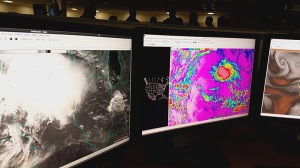Project Atmosphere Begins A Summer PD
So my summer began on quiet note this year. I didn’t have any PD’s (Professional Development) at the beginning. Something of an oddity for me. But then I applied to the Project Atmosphere experience. Supported by NOAA and NSF, the American Meteorological Society hosted a 12 day workshop that was all about weather. Something I teach in class and felt I needed a better background in. I took the DataExtreme Weather course through AMS. The course was very informative and gave me a good background in meteorology. So I took a chance and applied to the summer experience. Well that’s where I am now. I did get accepted.
The next few entries will be about the experience and some of the resources I’m obtaining from the course. One thing to remember about this experience it is for 12 days and that means almost two weeks away from home. It also is at the end of July, for me that is near the end of my summer vacation something I had to get use to and plan around. But well worth it!
The experience started on July 17th, Sunday. We all had to arrive in Kansas City Missouri before 4pm. The hotel was pretty decent and the first night was a get to know you night. There are 24 participants in the workshop. Everyone comes from various grade levels and across the country. The next day really started the experience. We would be meeting every day at the Kansas City National Weather Service Training Center. The day would start at 8 am and end at 4:30 pm. Our first day was filled with guest speakers and welcomes. Our four leaders during the workshop were Jim Brey, Bob Weinbeck, Chad Kauffman and Abby Stimach all a part of AMS. We were welcomed by John Ogren who is the director of the center. Then Mr. Brey would introduced us to the AMS education and what the future would look like with the program. Part of our day throughout the workshop would be our daily briefing on weather by Jerry Griffin. Using various maps from the NWS, Mr. Griffin discussed how to read a water vapor map, surface weather stations and convective maps. Most of these can be found at the National Weather Service Website.

During the day they introduced us to Modules that the AMS developed for teachers. Some of these lessons and resources they presented you can get from the AMS website. The first module was about Highs/Lows. The lab used the hand model to help students understand the flow of air in pressure systems. There are videos on YouTube that show you how to use the model. Once we finished our module we took a tour of ASOS (Automated Surface Observing Site). This ended our first day. Already racking up a ton of information and resources for the future.
“Automated Surface Observing System (ASOS) units are automated sensor suites that are designed to serve meteorological and aviation observing needs. There are currently more than 900 ASOS sites in the United States. These systems generally report at hourly intervals, but also report special observations if weather conditions change rapidly and cross aviation operation thresholds.” (https://goo.gl/ZqdyJu, NOAA National Centers for Environmental Information)

ASOS equipment

ASOS training site

ASOS Map of all sites

Satellite Imagery
The second day included a talk by Chad Kauffman, a professor at California University of Pennsylvania. Mr. Kauffman presented a ton of information on Skywarn and Pennsylvania State University e-Wall The Electronic Map Wall. Two great resources for teachers to use, but a warning, the second resource can be difficult to understand. It does have a great map resources. He did a great job explaining basic weather concepts. If you want to follow him on twitter here is his handle @TripleVortex. After his talk Adam Stout came in talked about Satellite imagery and took us on a tour through the Satellite office. The one exciting point he made in his presentation was about GOES-R Satellite. A game changer for climate and weather.
The third day included a full day of guest speakers on various topics. The day started with research on Climate, Weather, and Laura Ingalls Wilder: Connecting Science to Narrative by Barb Mayes Boustead, Ph.D. A very different view of Laura Ingalls novels and the weather she wrote about in her novels, Dr. Boustead focused on the “The Long Winter” Wilder Book- 1880-1881, you can follow on twitter by the way @windbarb. Dr. Boustead talked about various parts of Ingalls novels that mentioned different weather events and using various research to collaborate the events. Her discussion included the El Nino, La Nino and their effects on various parts of the United States. During the discussion she mentioned an event that took place 1888, called the Children’s Blizzard. A tragic event that caused many deaths among immigrant children during an unexpected blizzard. I would never had thought of associating Laura Ingalls novels with weather, but it works and Dr. Boustead did a great job explaining this whole topic.
After Dr. Boustead, we had our weather briefing by Jerry Griffin again. Of course nothing changed because of the High that was sitting over the center of the country. The day ended with a lesson on the electromagnetic spectrum. By the end of the day I had more information then I knew what to do with. And as for the other participants, there are a great bunch of educators here and they have some really good ideas. So far the workshop has not disappointed me.
Posted on July 24, 2016, in Class Ideas, DataStreme, Earth Science, Meteorlogy, Project Atmosphere, Teacher Workshop. Bookmark the permalink. Leave a comment.

Leave a comment
Comments 0